Papers by Mina Namvari

Nanohybrids of graphene with water soluble polymer were synthesized using ‘grafting from’ method.... more Nanohybrids of graphene with water soluble polymer were synthesized using ‘grafting from’ method. GO, prepared by modified Hummers’ method, was first reacted with sodium azide. Alkyne-terminated RAFT-CTA was synthesized by reaction of propargyl alcohol and S-1-dodecyl-S’-(α,α‘-dimethyl-α”-acetic acid) trithiocarbonate. RAFT-CTA was grafted onto the GO sheets by facile click-reaction and subsequently, N-isopropylacrylamide (NIPAM) and N-ethyleacrylamide (NEAM) were polymerized on graphene sheets via RAFT polymerization method. The respective copolymers with different ratios were also prepared. The nanohybrids were characterized by FTIR, XRD, TGA, Raman, SEM, and AFM. Both SEM and AFM clearly showed rod-like structures for rGO-PNEAM. XRD showed a small peak at 2θ=19.21°, corresponding to d-spacing≈4.6 Å. In addition, the nanohybrids showed a very broad temperature range for the LCST in water between ca. 30 and 70 °C.
International Journal of Environmental Science and Technology
Magnetic glucose-functionalized graphene nanosheets (GNS) were prepared, and the application of t... more Magnetic glucose-functionalized graphene nanosheets (GNS) were prepared, and the application of these biosorbents in the removal of methylene blue was investigated. Fe 3 O 4 nanoparticles were deposited on sweet GNS using coprecipitation. The nanocomposites were analyzed by Fourier transform infrared spectroscopy, field emission scanning electron microscopy, transition electron microscopy, vibrating sample magnetometer and X-ray diffraction spectrometry. The resulted magnetic sweet GNS were superparamagnetic, responded quickly to an external magnetic field and exhibited efficient adsorption toward methylene blue, as a cationic dye. No leaching was observed even after a week of placing a magnet close to the vial containing the solution of magnetic sweet GNS.
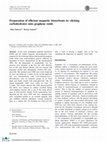
In this work, hydrophilic graphene nanosheets (GNS) and the related magnetic nanocomposites were ... more In this work, hydrophilic graphene nanosheets (GNS) and the related magnetic nanocomposites were prepared by first tethering alkyne-functionalized graphene oxide (GO) with azide-modified glucose followed by deposition of Fe3O4 nanoparticles on the functionalized GNS. For the preparation of nanohybrids, two approaches were designed: in the first one, after chlorination of GO with thionyl chloride, GO was reacted with propargyl alcohol and subsequently clicked with azide-glucoside. The resulted sweet GNS were easily dispersed in water and stable for two weeks. In the second approach, GO was functionalized with 3, 4, 5-tris (prop-2-yn-1-yloxy) benzoic acid via hydroxyl groups on its basal plane and finally treated with azide-glucoside. The obtained hydrophilic GNS were stable in water for three weeks. The results showed that both glucose-grafted GO sheets were reduced by sodium ascorbate during click-coupling reaction; this is one of the many advantages of click reaction. Finally, Fe3O4 nanoparticles were deposited on the sweet GNS and were superparamegnetic, responded quickly to an external magnetic field and exhibited efficient adsorption towards methylene blue, as a cationic dye. No leaching was observed even after a week of placing a magnet close to the vial containing the dispersion of magnetic sweet GNS.
Cheminform, 2009
ChemInform is a weekly Abstracting Service, delivering concise information at a glance that was e... more ChemInform is a weekly Abstracting Service, delivering concise information at a glance that was extracted from about 200 leading journals. To access a ChemInform Abstract of an article which was published elsewhere, please select a “Full Text” option. The original article is trackable via the “References” option.
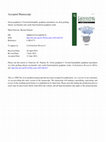
Water-soluble graphene nanosheets (GNS) were fabricated via functionalization of graphene oxide (... more Water-soluble graphene nanosheets (GNS) were fabricated via functionalization of graphene oxide (GO) with mono and disaccharides on the basal plane and edges using Cu (I)-catalyzed Huisgen 1,3-dipolar cycloaddition of azides and terminal alkynes (Click Chemistry). To graft saccharides onto the plane of GO, it was reacted with sodium azide to introduce azide groups on the plane. Then, it was treated with alkyne-modified glucose, mannose, galactose and maltose. In the next approach, we attached 1, 3-diazideoprop-2-ol onto the edges of GO and it was subsequently clicked with alkyne-glucose. The products were analyzed by Fourier-transform infrared spectroscopy (FTIR), field-emission scanning electron microscopy, thermogravimetric analysis (TGA) and X-ray diffraction spectrometry. FTIR and TGA results showed both sugargrafted GO sheets were reduced by sodium ascorbate during click-coupling reaction which is an advantage for this reaction. Besides, glycoside-grafted GNS were easily dispersed in water and stable for two weeks.

Polymer International-Wiley
A magnetic nanocomposite of citric-acid-functionalized graphene oxide was prepared by an easy met... more A magnetic nanocomposite of citric-acid-functionalized graphene oxide was prepared by an easy method. First, citric acid (CA) was covalently attached to acyl-chloride-functionalized graphene oxide (GO). Then, Fe3O4 magnetic nanoparticles (MNPs) were chemically deposited onto the resulting adsorbent. CA, as a good stabilizer for MNPs, was covalently attached to the GO; thus MNPs were adsorbed much more strongly to this framework and subsequent leaching decreased and less agglomeration occurred. The attachment of CA onto GO and the formation of the hybrid were confirmed by Fourier transform infrared spectroscopy, scanning electron microscopy, X-ray diffraction spectrometry and transmission electron microscopy. The specific saturation magnetization of the magnetic CA-grafted GO (GO-CA-Fe3O4) was 57.8 emu g−1 and the average size of the nanoparticles was found to be 25 nm by transmission electron microscopy. The magnetic nanocomposite was employed as an adsorbent of methylene blue from contaminated water. The adsorption tests demonstrated that it took only 30 min to attain equilibrium. The adsorption capacity in the concentration range studied was 112 mg g−1. The GO-CA-Fe3O4 nanocomposite was easily manipulated in an external magnetic field which eases the separation and leads to the removal of dyes. Thus the prepared nanocomposite has great potential in removing organic dyes. © 2014 Society of Chemical Industry
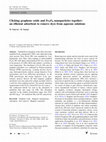
International Journal of Environmental Science and Technology-Springer
Nanohybrid of graphene oxide (GO) and azide-modified Fe3O4 nanoparticles (NPs) were fabricated us... more Nanohybrid of graphene oxide (GO) and azide-modified Fe3O4 nanoparticles (NPs) were fabricated using click reaction. First, Fe3O4 NPs were modified by 3-azidopropionic acid. Then, click-coupling of azide-modified Fe3O4 NPs with alkyne-functionalized GO was carried out in the presence of CuSO4·5H2O and sodium l-ascorbate at room temperature. The attachment of Fe3O4 NPs onto the graphene nanosheets was confirmed by Fourier-transform infrared (FTIR) spectroscopy, scanning electron microscopy, thermogravimetric analysis, energy dispersive X-ray spectrometry and X-ray diffraction spectrometry. As the FTIR spectroscopy and energy dispersive X-ray spectrometry analysis showed, the final magnetic graphene nanosheets were also reduced by sodium ascorbate which is a merit for click-coupling reactions. The specific saturation magnetization of the Fe3O4-clicked GO was 44.3 emu g−1. The synthesized hybrid was used in the adsorption of methylene blue and congo red (CR). The adsorption capacities in the studied concentration range were 109.5 and 98.8 mg g−1 for methylene blue and CR, respectively.
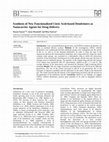
Citric acid-polyethylene glycol-citric acid (CPEGC) triblock dendrimers can serve as potential de... more Citric acid-polyethylene glycol-citric acid (CPEGC) triblock dendrimers can serve as potential delivery systems. Methods: In this investigation, CPEGC triblock dendrimers were synthesized and then imidazole groups were conjugated onto the surface of the G 1 , G 2 and G 3 of the obtained dendrimers. In order to study the type of the interactions between the functionalized dendrimers and a drug molecule, Naproxen which contains acidic groups, was examined as a hydrophobic drug in which the interactions would be of the electrostatic kind between its acidic groups and the lone pair electrons of nitrogen atom in imidazole groups. The quantity of the trapped drug and also the amount of its release were measured with UV spectrometric method in pH 1, 7.4 and 10. The average diameter of the nanocarriers was measured by Dynamic Light Scattering (DLS) technique Results: The size range of particles was determined to be 16-50 nm for different generations. The rate of the release increased in pH=10 in all generations due to the increases in Naproxen solubility and the hydrolysis of the esteric bonds in the mentioned pH. The results showed that the amount of the trapped drug increased with the increase in the generation of the dendrimer and pH. Conclusion: Based on our findings, we suggest CPEGC triblock dendrimers possess great potential to be used as drug/gene delivery system.
The synthesis of various vinylbis(silanes) from some aryl and heteroaryl aldehydes and (Me 3 Si) ... more The synthesis of various vinylbis(silanes) from some aryl and heteroaryl aldehydes and (Me 3 Si) 3 CLi in Et 2 O is described. Friedel-Crafts reaction of 1,1-bis(trimethylsilyl)-2-(2-naphthyl)ethene with various acyl chlorides (RCOCl, R = Me, Et, i-Pr, i-Bu, n-pent) gave the corresponding a-silyl-a,b-unsaturated enones with high E steroselectivity. Moreover, poly(styrene)-co-[2,2-bis(trimethylsilyl)ethenyl(styrene)] obtained via the reaction of polymers bearing pendant enone functions and (Me 3 Si) 3 CLi, reacts with the same acyl chlorides in the presence of catalytic amount of AlCl 3 to give the new macromolecules bearing a-silyl-a,b-unsaturated enones and a,b-unsaturated enones.
Conference Presentations by Mina Namvari
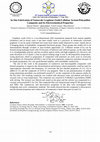
Graphene oxide (GO) is a two-dimensional (2D) nonmaterial prepared from natural graphite (Scheme1... more Graphene oxide (GO) is a two-dimensional (2D) nonmaterial prepared from natural graphite (Scheme1) and in recent years it has been widely used as a precursor of chemically converted graphene. It can be easily exfoliated into mono layer sheets stably dispersed in water, mainly due to it bringing plenty of hydrophilic oxygenated functional groups. These groups also enable GO to be functionalized through covalent or non-covalent approaches . Cellulose acetate (CA) can be formed strong hydrogen bond with GO because of hydroxyl and carboxyl groups, on the other hand it is a biodegradable polymer and has excellent optical clarity and high toughness . However, the main drawback of CA plastic is that its typical melting range is near its decomposition temperature. Using plasticizer, blend or preparation of composites with polymers are some ways to overcome this problem . Polyaniline (PANI) is one of the most important conductive polymers because of its simple preparation, low cost, good thermal stability, and controllable conductivity.
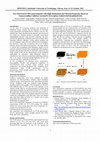
In the wake of increasing pollution and depleting of traditional energy resource, the development... more In the wake of increasing pollution and depleting of traditional energy resource, the development of renewable energy production and hybrid electric vehicles with low CO2 emission have been attracting much attention since the end of last century [1]. Cellulose acetate is renewable source-based biodegradable polymer with excellent properties has been used for the application in different areas such as fibers, films, laminates, adhesive substance, coating, plastic products and etc. [2]. Graphene oxide (GO), the oxidized state of graphene, has attracted a great deal of attention, due to its excellent thermal, electric and mechanical properties. The large surface to volume ratio of graphene oxide nanosheets renders it as an attractive substrate material when compounded with inorganic particles and polymers. But the low electrical conductivity and acidic groups of GO are the disadvantages in any potentaial applications [3]. Therefore, using polyaniline which is considered as one of the m...








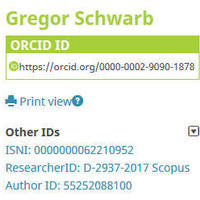

Uploads
Papers by Mina Namvari
Conference Presentations by Mina Namvari